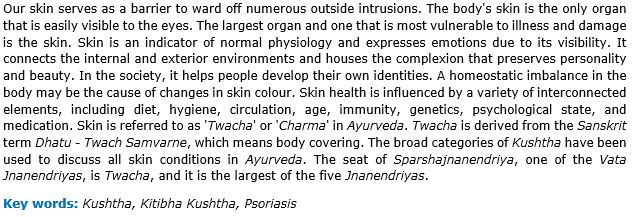An overview of Kustha and its management approaches in Ayurvedic texts
DOI:
https://doi.org/10.21760/jaims.8.6.15Keywords:
Kushtha, Kitibha Kushtha, PsoriasisAbstract
Our skin serves as a barrier to ward off numerous outside intrusions. The body's skin is the only organ that is easily visible to the eyes. The largest organ and one that is most vulnerable to illness and damage is the skin. Skin is an indicator of normal physiology and expresses emotions due to its visibility. It connects the internal and exterior environments and houses the complexion that preserves personality and beauty. In the society, it helps people develop their own identities. A homeostatic imbalance in the body may be the cause of changes in skin colour. Skin health is influenced by a variety of interconnected elements, including diet, hygiene, circulation, age, immunity, genetics, psychological state, and medication. Skin is referred to as 'Twacha' or 'Charma' in Ayurveda. Twacha is derived from the Sanskrit term Dhatu - Twach Samvarne, which means body covering. The broad categories of Kushtha have been used to discuss all skin conditions in Ayurveda. The seat of Sparshajnanendriya, one of the Vata Jnanendriyas, is Twacha, and it is the largest of the five Jnanendriyas.
Downloads
References
Charak Samhita" with Hindi Vidyotini Commentary by Pt. Kashinath Shastri and Dr. Gorakhnath Chaturvedi, Part 1, has been reprinted by Chaukhamba Bharti Academy in Varanasi in 2002.
Sushrut Samhita. Dr. Shastri Ambikadutt, published in Varanasi in 2002 by Chaukhamba Sanskrit Sansthan, specifically focuses on the Nidansasthana section.
Vaidya Yadunandana Upadhyaya edited the "Astanga Hrdayam Nidansthana" by Vagbhata, which includes the 'Vidyotini' Hindi Commentary by Kaviraja Atrideva Gupta. This edition was published by Chaukhamba Sanskrit Sansthan in Varanasi in 2005.
Chaukhamba Visvabharti in Varanasi reprinted the "Bhel Samhita" Nidan sthana text in 2008. This edition includes an English translation, commentary, and critical notes by Dr. K.H. Krishnaurthy, which were edited by Prof. PriyaVrat Sharma.
Parameswarappa's Ayurvediya Vikriti Vigyan & Roga Vigyan. Volume II, 1st edition, was written by Byadgi P.S. and published by Chaukhambha Sanskrit Sansthan in Varanasi in 2009. The book focuses on Kushtha.















